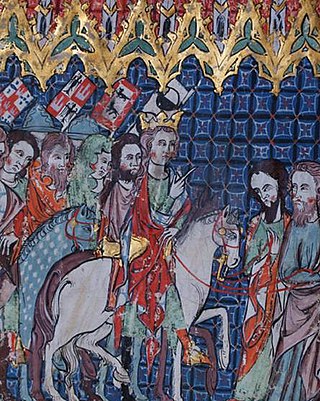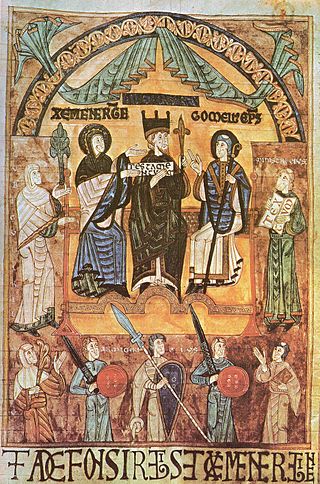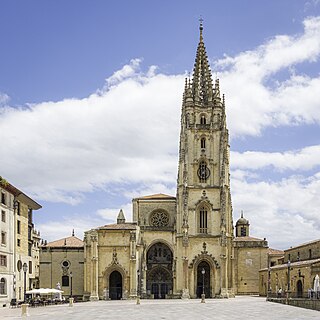
Alfonso XI, called the Avenger, was King of Castile and León. He was the son of Ferdinand IV of Castile and his wife Constance of Portugal. Upon his father's death in 1312, several disputes ensued over who would hold regency, which were resolved in 1313.

Alfonso VII, called the Emperor, became the King of Galicia in 1111 and King of León and Castile in 1126. Alfonso, born Alfonso Raimúndez, first used the title Emperor of All Spain, alongside his mother Urraca, once she vested him with the direct rule of Toledo in 1116. Alfonso later held another investiture in 1135 in a grand ceremony reasserting his claims to the imperial title. He was the son of Urraca of León and Raymond of Burgundy, the first of the House of Ivrea to rule in the Iberian Peninsula.

Alfonso III, called the Great, was king of Asturias from 866 until his death. He was the son and successor of Ordoño I. After his death, the Kingdom of Asturias was split between his sons, with García inheriting León, Ordoño inheriting Galicia, and Fruela inheriting Asturias.

The County of Ribagorza or Ribagorça was a medieval county on the southern side of the Pyrenees, including the northeast of modern Aragón and part of the northwest of modern Catalonia, both in Spain. It was originally the independent creation of a local dynasty, later absorbed into the Kingdom of Navarre and then into the Crown of Aragon. It had a strong historical connection with the neighboring counties of Sobrarbe and Pallars. Its territory consisted of the valleys of the rivers Ésera, Isábena, and Noguera Ribagorzana. The seat of its counts was at Benabarre. Other notable towns include Benasque, Graus and Pont de Suert. Today the western portion of the county roughly corresponds to the Aragonese comarca of Ribagorza, with its administrative centre in Graus; the eastern portion roughly corresponds to the Catalan comarca of Alta Ribagorça.

Ferdinand I, called the Great, was the count of Castile from his uncle's death in 1029 and the king of León after defeating his brother-in-law in 1037. According to tradition, he was the first to have himself crowned Emperor of Spain (1056), and his heirs carried on the tradition. He was a younger son of Sancho III of Navarre and Muniadona of Castile, and by his father's will recognised the supremacy of his eldest brother, García Sánchez III of Navarre. While Ferdinand inaugurated the rule of the Navarrese Jiménez dynasty over western Spain, his rise to preeminence among the Christian rulers of the peninsula shifted the focus of power and culture westward after more than a century of Leonese decline. Nevertheless, "[t]he internal consolidation of the realm of León–Castilla under Fernando el Magno and [his queen] Sancha (1037–1065) is a history that remains to be researched and written."

Alfonso García Robles was a Mexican diplomat and politician who, in conjunction with Sweden's Alva Myrdal, received the Nobel Peace Prize in 1982.

The Kingdom of Castile was a polity in the Iberian Peninsula during the Middle Ages. It traces its origins to the 9th-century County of Castile, as an eastern frontier lordship of the Kingdom of León. During the 10th century, the Castilian counts increased their autonomy, but it was not until 1065 that it was separated from the Kingdom of León and became a kingdom in its own right. Between 1072 and 1157, it was again united with León, and after 1230, the union became permanent.

Mexico competed at the 1972 Summer Olympics in Munich, West Germany. 174 competitors, 152 men and 22 women, took part in 112 events in 20 sports.

García Ramírez, sometimes García IV, V, VI or VII, called the Restorer, was the King of Navarre (Pamplona) from 1134. The election of García Ramírez restored the independence of the Navarrese kingdom after 58 years of political union with the Kingdom of Aragon. After some initial conflict he would align himself with king Alfonso VII of León and Castile, and as his ally take part in the Reconquista.

Ramiro II, son of Ordoño II and Elvira Menendez, was a King of León from 931 until his death. Initially titular king only of a lesser part of the kingdom, he gained the crown of León after supplanting his brother Alfonso IV and cousin Alfonso Fróilaz in 931. The scant Anales castellanos primeros are a primary source for his reign.

García II, King of Galicia, was the youngest of the three sons and heirs of Ferdinand I, King of Castile and León, and Sancha of León, whose Leonese inheritance included the lands García would be given. Garcia first appears in an 11 September 1064 settlement with Suero, Bishop of Mondoñedo, his father confirming the agreement.

The Metropolitan Cathedral Basilica of the Holy Saviour or Cathedral of San Salvador is a Roman Catholic church and minor basilica in the centre of Oviedo, in the Asturias region of northern Spain.

Sancho II, called the Strong, was King of Castile (1065–72), Galicia (1071–72) and León (1072).

Ordoño II was a king of Galicia from 910, and king of Galicia and León from 914 until his death. He was an energetic ruler who submitted the kingdom of Leon to his control and fought successfully against the Muslims, who still dominated most of the Iberian Peninsula. His reign marked the tactical and smooth transition of the regnum Asturum to the regnum Legionis, with the royal headquarters already established in the city of León.

Infante Alfonso of Spain, Prince of the Two Sicilies, Duke of Calabria was one of two claimants to the title of the head of the House of Bourbon-Two Sicilies from 1960 until his death in 1964. Alfonso was the son of Prince Carlos of Bourbon-Two Sicilies (1870–1949) and his wife, María de las Mercedes, Princess of Asturias (1880–1904). He was born and died in Madrid, Spain.

Imperator totius Hispaniae is a Latin title meaning "Emperor of All Spain". In Spain in the Middle Ages, the title "emperor" was used under a variety of circumstances from the ninth century onwards, but its usage peaked, as a formal and practical title, between 1086 and 1157. It was primarily used by the kings of León and Castile, but it also found currency in the Kingdom of Navarre and was employed by the counts of Castile and at least one duke of Galicia. It signalled at various points the king's equality with the rulers of the Byzantine Empire and Holy Roman Empire, his rule by conquest or military superiority, his rule over several ethnic or religious groups, and his claim to suzerainty over the other kings of the peninsula, both Christian and Muslim. The use of the imperial title received scant recognition outside of Spain and it had become largely forgotten by the thirteenth century.
García Ordóñez, called de Nájera or de Cabra and Crispus or el Crespo de Grañón in the epic literature, was a Castilian magnate who ruled the Rioja, with his seat at Nájera, from 1080 until his death. He is famous in literature as the rival of Rodrigo Díaz de Vivar, the Cid, whose high position at court he took over after the Cid's exile in 1080. He was one of the most important military leaders and territorial governors under Alfonso VI, and was entrusted with military tutorship of the king's heir, Sancho Alfónsez, with whom he died on the field of battle at Uclés.
Alfonso García de Vinuesa was a Spanish racing driver from Madrid.
Princess Inés of Bourbon-Two Sicilies, Duchess of Syracuse, GE is a Spanish princess, the youngest child of Infante Alfonso, heir to the throne of the Two Sicilies, and Infanta Alicia.















